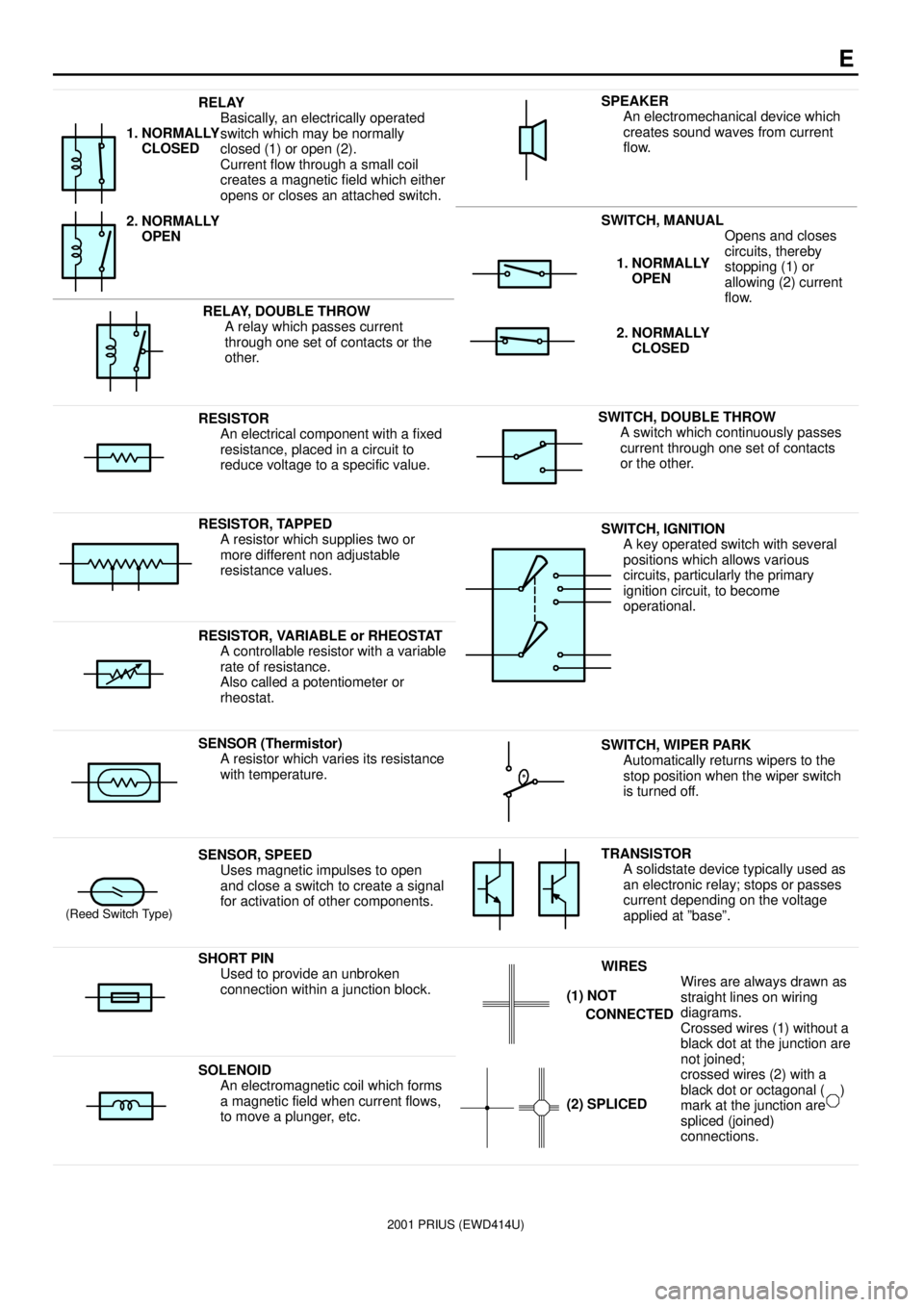Page 19 of 1943

2001 PRIUS (EWD414U)
E
RELAY
Basically, an electrically operated
switch which may be normally
closed (1) or open (2).
Current flow through a small coil
creates a magnetic field which either
opens or closes an attached switch.
1. NORMALLY
CLOSED
2. NORMALLY
OPEN
SWITCH, MANUAL
Opens and closes
iitth b
SPEAKER
An electromechanical device which
creates sound waves from current
flow.
RELAY, DOUBLE THROW
A relay which passes current
through one set of contacts or the
other.
circuits, thereby
stopping (1) or
allowing (2) current
flow.1. NORMALLY
OPEN
2. NORMALLY
CLOSED
RESISTOR
An electrical component with a fixed
resistance, placed in a circuit to
reduce voltage to a specific value.SWITCH, DOUBLE THROW
A switch which continuously passes
current through one set of contacts
or the other.
RESISTOR, TAPPED
A resistor which supplies two or
more different non adjustable
resistance values.SWITCH, IGNITION
A key operated switch with several
positions which allows various
circuits, particularly the primary
ignition circuit, to become
operational.
RESISTOR, VARIABLE or RHEOSTAT
A controllable resistor with a variable
rate of resistance.
Also called a potentiometer or
rheostat.
SENSOR (Thermistor)
A resistor which varies its resistance
with temperature.SWITCH, WIPER PARK
Automatically returns wipers to the
stop position when the wiper switch
is turned off.
(Reed Switch Type)
SENSOR, SPEED
Uses magnetic impulses to open
and close a switch to create a signal
for activation of other components.TRANSISTOR
A solidstate device typically used as
an electronic relay; stops or passes
current depending on the voltage
applied at ºbaseº.
SHORT PIN
Used to provide an unbroken
connection within a junction block.WIRES
Wires are always drawn as
straight lines on wiring
diagrams.
Crossed wires (1) without a
black dot at the junction are
tj i d
(1) NOT
CONNECTED
SOLENOID
An electromagnetic coil which forms
a magnetic field when current flows,
to move a plunger, etc.
j
not joined;
crossed wires (2) with a
black dot or octagonal ( )
mark at the junction are
spliced (joined)
connections.
(2) SPLICED
Page 285 of 1943
ENGINE ± 1NZ-FXE ENGINE
182EG03
N.m
120
110
100
90
80
Torque
1000 2000 3000 4000 5000
Engine Speed (rpm)kW
60
50
40
30
20
10
Output
0 44
� Engine Specifications �
Engine Type1NZ-FXE1NZ-FE (ECHO)
No. of Cyls. & Arrangement4-Cylinder, In-line�
Valve Mechanism16 Valve DOHC, Chain Drive�
Combustion ChamberPentroof Type�
ManifoldsCross-Flow�
Fuel SystemSFI�
Displacement cm3 (cu. in.)1497 (91.3)�
Bore x Stroke mm (in.)75.0 x 84.7 (2.95 x 3.33)�
Compression Ratio13.0 : 110.5 : 1
Max. Output [SAE-NET]52 kW @ 4500 rpm
70 HP @ 4500 rpm81 kW @ 6000 rpm
108 HP @ 6000 rpm
Max. Torque [SAE-NET]111 N.m @ 4200 rpm
82 lb-ft @ 4200 rpm142 N.m @ 4200 rpm
105 lb-ft @ 4200 rpm
IntakeOpen18� � ±25� BTDC±7� � 53� BTDC
Valve
IntakeClose72� � 115� ABDC52� � ±8� ABDCValve
Timing
ExhaustOpen34� BBDC42� BBDCg
ExhaustClose2� AT D C�
Fuel Octane Number RON91 or more�
Oil GradeAPI SJ EC or ILSAC�
� Performance Curve �
Page 286 of 1943

ENGINE ± 1NZ-FXE ENGINE45
�FEATURES OF 1NZ-FXE ENGINE
The 1NZ-FXE engine has been able to achieve the following performance through the adoption of the items
listed below.
(1) High performance and fuel economy
(2) Low noise and vibration
(3) Lightweight and compact design
(4) Good serviceability
(5) Clean emission
Item
(1)(2)(3)(4)(5)1NZ-FE
The VVT-i system is used.���
High-expansion Atkinson cycle has been adopted.�
An offset crankshaft has been adopted.��
A cylinder block made of aluminum has been adopted.���
A stainless steel exhaust manifold is used for weight reduction.���
A rearward exhaust layout has been adopted to realize the early
activation of the catalyst.��
HC Adsorber and catalyst system has been adopted.�
Fuel returnless system has been adopted.��
12-hole type fuel injectors have been adopted.���
The DIS (Direct Ignition System) makes ignition timing
adjustment unnecessary.��
Quick connectors are used to connect the fuel hose with the
fuel pipes.��
The oil filter is installed diagonally downward.��
A timing chain has been adopted.��
A vacuum system that detects leaks in the evaporative
emission control system has been adopted.���
The vapor reducing fuel tank system has been adopted.
This system reduces the amount of fuel vapor that is generated.�
Page 288 of 1943

ENGINE ± 1NZ-FXE ENGINE
182EG05
FrontExhaust Side
Crankshaft Center
Bore Center
8 mm
Intake Side12 mm
182EG06
Taper Squish Shape47
2. Cylinder Block
�A cylinder block made of aluminum alloy has been adopted to realize a significant amount of weight reduc-
tion.
�A water pump swirl chamber and an inlet passage to the pump are provided in the cylinder block.
�The rear portion of the cylinder block has been shaped conically to improve the coupling rigidity with the
transaxle.
�Through the adoption of the offset crankshaft, the bore center has been shifted 12 mm towards the intake,
in relation to the crankshaft center. Thus, the side force when the maximum pressure is applied has been
reduced and the heat efficiency has been improved. And as a result, fuel economy has been improved.
�Through the use of a thin-walled cast iron liner in the cylinder bore, a distance of 8 mm between the bores
has been realized, resulting in a compact package. This liner is thin, so that boring is not possible.
�By discontinuing the use of the rear oil seal retainer and by pressing the rear oil seal into the cylinder block,
a compact package has been realized.
3. Piston
�The taper squish shaped piston has been
adopted to improve combustion chamber.
�Low-tension piston rings have been adopted to
reduce friction and improve fuel economy and
oil consumption performance.
�By increasing the mechining precision of the
cylinder bore diameter, the outer diameter of
the piston has been made into the one type.
Page 292 of 1943
ENGINE ± 1NZ-FXE ENGINE
171EG13
Spring
Plunger
Cam
Cam Spring Check Ball
171EG32171EG31
Service Hole for
Chain Tensioner
Oil Pump
Front ViewBack View51
5. Chain Tensioner
�The chain tensioner uses a spring and oil pres-
sure to maintain proper chain tension at all
times.
The chain tensioner suppresses noise generated
by the chain.
�A ratchet type half-back mechanism is used.
6. Timing Chain Cover
�A single-piece, aluminum die-cast timing chain cover that entirely seals the front portion of the cylinder
block and the cylinder head has been adopted.
�A service hole for the chain tensioner has been provided in the timing chain cover to improve serviceabili-
ty.
Page 293 of 1943
ENGINE ± 1NZ-FXE ENGINE
182EG08
182EG09
MAIN OIL HOLE
RELIEF
VA LV E
RELIEF
VA LV E
OIL FILTER
OIL PUMP
OIL STRAINER
CRANKSHAFT
JOURNAL
CONNECTING
RODOIL JET
PISTON OIL JET
TIMING CHAINCHAIN
TENSIONER
CYLINDER HEAD
CAMSHAFT TIMING
OIL CONTROL VALVE
FILTER
INTAKE
CAMSHAFT
JOURNALEXHAUST
CAMSHAFT
JOURNAL
CAMSHAFT TIMING
OIL CONTROL VALVE
VVT-i
OIL PAN 52
�LUBRICATION SYSTEM
�The lubrication circuit is fully pressurized and all oil passes through an oil filter.
�A trochoid gear type oil pump, which is driven directly by the crankshaft, has been provided in the front
of the cylinder block.
�The oil filter has been installed diagonally downward from the side of the cylinder block to improve ser-
viceability.
Page 308 of 1943

ENGINE ± 1NZ-FXE ENGINE
182EG24
VVT-i Controller
ECM
Camshaft Position
Sensor
Camshaft Timing
Oil Control Valve Crankshaft
Position
Sensor67
5. Main Components of Engine Control System
The main components of the 1NZ-FXE engine control system are as follows:
Components
OutlineQuantity
Mass Air Flow MeterHot-Wire Type1
Crankshaft Position Sensor (Rotor's Teeth)Pick-Up Coil Type (36-2)1
Camshaft Position Sensor (Rotor's Teeth)Pick-Up Coil Type (3)1
Throttle Position SensorLinear Type (Double)1
Knock SensorBuilt-In Piezoelectric Element Type1
Oxygen Sensor
Heated Oxygen Sensor
(Bank 1, Sensor 1)
(Bank 1, Sensor 2)
2
Injector12-Hole Type4
6. VVT-i (Variable Valve Timing-intelligent) System
General
The VVT-i system is designed to control the intake camshaft within a wide range of 43� (of crankshaft
angle) to provide a valve timing that is optimally suited to the engine condition, thus realizing improved
torque in all the speed ranges and fuel economy, and reduce exhaust emissions.
Page 341 of 1943
CHASSIS ± P111 HYBRID TRANSAXLE
CHASSIS
182CH01
MG (Motor Generator) 2Power Splitting Device
MG (Motor Generator) 1
Transaxle Damper
Differential Oil Pump79
P111 HYBRID TRANSAXLE
�DESCRIPTION
The P111 hybrid transaxle has been newly developed for the hybrid system application.
Containing a MG (Motor Generator) 2 for driving the vehicle and a MG (Motor Generator) 1 for generating
electrical power, the P111 hybrid transaxle uses a continuously variable transmission mechanism with power
splitting device that achieve smooth and quiet operation.
� Specifications �
Pl t
The No. of Ring Gear Teeth78
Planetary
GearThe No. of Pinion Gear Teeth23Gear
The No. of Sun Gear Teeth30
Gear Ratio3.905
Number of Links74
ChainDrive Sprocket39
Driven Sprocket36
Counter GearDrive Gear30Counter GearDriven Gear44
Final GearDrive Gear26Final GearDriven Gear75
Fluid Capacity Liters (US qts, Imp.qts)4.6 (4.9, 4.0)
Fluid TypeATF Type T-IV or equivalent